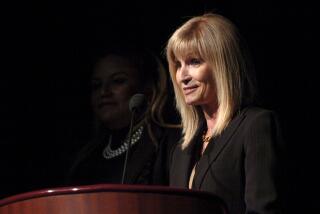KOST-FM earns big ratings victory
Every December, KOST-FM (103.5) and its all-holiday playlist shower the Los Angeles-Orange County radio landscape with a “White Christmas.” This year it was more like a snowpocalypse.
The adult-contemporary station trounced its competitors in the year-end ratings, released Tuesday by the Arbitron ratings service. From Dec. 9 to Jan. 5, among listeners 6 and older, KOST claimed a 9.3% share of the audience. Second-place KIIS-FM (102.7), the pop-music station, trailed far behind at 5.4%.
“I think now KOST is branded as the holiday music station — if you go to KOST, it’s Christmas,” said Stella Prado, the station’s program director. She said she heard the station being played at malls, gas stations and more public places than she was used to. “We were the soundtrack to the season.”
KIIS had dominated the local radio ratings throughout 2010, leading the pack from January to November. It had been the only station in Los Angeles and Orange County to top 4 million in average audience — the number of listeners who tuned in for at least five minutes in a given week — peaking at 4.16 million in August. But during the holidays, KOST tallied an astonishing 4.9 million.
KOST’s win was even wider than the previous year, when it beat KIIS during the holidays 8.1% to 4.9%. In 2009, its weekly audience totaled 4.5 million, compared to KIIS’ 3.7 million.
KOST had company in seeing success with a continuous Christmas. In New York City, WLTW-FM and its all-holiday music crushed second-place WCBS-FM, 12.3% to 4.8%.
“There’s no question this is an amazing phenomenon, and it disrupts completely the rest of the market,” said Jeff Pollack, chairman of the Pollack Media Group, an L.A.-based media-consulting firm. “It affects everybody. It’s impossible to gauge how your station is doing because of this amazing aberration.”
The scope of KOST’s win also shows in that it won every demographic and every part of the day, Prado said. Last year during the holidays, perennial morning leader KFI-AM (640), the talk station that’s home to Bill Handel and Rush Limbaugh, still held onto the top spot.
But this year KOST beat the longtime champ, claiming 6.5% of the weekday audience from 6 to 10 a.m., compared with KFI’s 5.7%.
Its best showing was midday, though: From 10 a.m. to 3 p.m. weekdays, KOST claimed more than twice the audience share of its closest competitor, oldies station KRTH-FM (101.1), winning 10.3% to 5.1%.
Prado said this year KOST seemed to have less competition, with fewer stations pulling out the Bing Crosby, or Gene Autry singing about Rudolph. Competitors will add holiday music close to Christmas but didn’t do it as relentlessly or as early as KOST.
In some markets, more than one station will change to all-holiday music. But Prado said that’s more common, and more apt, in cold-weather cities.
“With the Southern California weather, I have to be careful with it,” Prado said. If the temperature is 80 degrees out, “people are just not in the Christmas spirit.”
This year, she planned to launch Nov. 19 but moved it up two days when a cold front was coming in. The station enlisted the aid of singer Michael Buble, who helped fire up KOST’s traditional kick-off song, Barry Manilow’s version of “White Christmas.”
The station started with the constant caroling in 2001, in part as an antidote to the Sept. 11, 2001, terrorist attacks. That tradition has made it the go-to station for many listeners wanting holiday cheer and created an ever-growing obstacle for competitors.
“When you establish that kind of beachhead,” Pollack said, “you end up owning it.”
“If you’re third or fourth in, you say to yourself, ‘Isn’t it better for me to continue what I’m doing?’” Pollack said, and maybe claim the listeners burned out on Christmas music.
Prado said she used to hear grumbling about the station starting too soon with the fa-la-las, but with retailers cloaking themselves in Christmas earlier every season, KOST’s music seems less like an outlier.
“We start getting calls in October, wondering when we’re going to flip,” Prado said. “It’s really funny.”
More to Read
The biggest entertainment stories
Get our big stories about Hollywood, film, television, music, arts, culture and more right in your inbox as soon as they publish.
You may occasionally receive promotional content from the Los Angeles Times.










